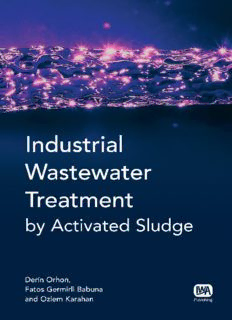
Industrial Wastewater Treatment by Activated Sludge PDF
Preview Industrial Wastewater Treatment by Activated Sludge
Industrial Wastewater Treatment by Activated Sludge Industrial Wastewater Treatment by Activated Sludge Derin Orhon, Fatos Germirli Babuna and Ozlem Karahan Publishedby IWA Publishing AllianceHouse 12CaxtonStreet LondonSW1H0QS,UK Telephone: þ44(0)2076545500 Fax: þ44(0)206545555 Email:[email protected] Web:www.iwapublishing.com Firstpublished2009 #2009IWAPublishing PrintedbyLightningSource Coverdesignbywww.designforpublishing.co.uk TypesetinIndiabyAldenPrepressServicesPrivateLimited. IndexprovidedbyChristineGraham. Apart from any fair dealing for the purposes of research or private study, or criticism or review, as permittedundertheUKCopyright,DesignsandPatentsAct(1998),nopartofthis publicationmaybereproduced,storedortransmittedinanyformorbyanymeans,withoutthe priorpermissioninwritingofthepublisher,or,inthecaseofphotographicreproduction,in accordancewiththetermsoflicencesissuedbytheCopyrightLicensingAgencyintheUK,or in accordance with the terms of licenses issued by the appropriate reproduction rights organizationoutsidetheUK.Enquiriesconcerningreproductionoutsidethetermsstatedhere shouldbesenttoIWAPublishingattheaddressprintedabove. The publisher makes no representation, express or implied, with regard to the accuracy of theinformationcontainedinthisbookandcannotacceptanylegalresponsibilityorliability forerrorsoromissionsthatmaybemade. Disclaimer Theinformationprovidedandtheopinionsgiveninthispublicationarenotnecessarilythose of IWA and shouldnot be acted upon without independent consideration and professional advice.IWAandtheAuthorwillnotacceptresponsibilityforanylossordamagesufferedby anypersonactingorrefrainingfromactinguponanymaterialcontainedinthispublication. BritishLibraryCataloguinginPublicationData ACIPcataloguerecordforthisbookisavailablefromtheBritishLibrary LibraryofCongressCataloging-in-PublicationData AcatalogrecordforthisbookisavailablefromtheLibraryofCongress ISBN:1843391449 ISBN13:9781843391449 Contents Foreword xiii 1 INTRODUCTION 1.1 NEED FOR BIOLOGICAL TREATMENT 3 1.2 NEW PERSPECTIVES 5 1.2.1 Hazardous wastes and micropollutants 5 1.2.2 Innovative treatment 7 2 ENERGETICS AND STOICHIOMETRY OF SUBSTRATE REMOVAL 2.1 ENERGETICS OF SUBSTRATE REMOVAL 11 2.1.1 Introduction 11 2.1.2 Biosynthesis 12 2.1.3 Energy generation and transformation 12 2.1.4 Nutritional classification of microorganisms 14 2.2 THE CONCEPT OF YIELD 16 2.2.1 Assessment of biomass 18 2.2.2 Assessment of substrate 20 2.2.2.1 The BOD parameter 20 2.2.2.2 The COD parameter 21 2.2.3 The definition of yield 22 2.2.4 Expression of yield for different model components 26 vi Industrial Wastewater Treatment by Activated Sludge 2.2.4.1 VSS as a biomass parameter 26 2.2.4.2 VSS and BOD as biomass and 5 substrate parameters 27 2.3 PROCESS STOICHIOMETRY 30 2.3.1 System defined with biomass COD and substrate COD 30 2.3.2 System defined with biomass VSS and substrate COD 31 2.3.3 System defined with biomass VSS and substrate BOD 32 5 2.4 REFERENCES 35 3 MODELLING OF ORGANIC CARBON REMOVAL 3.1 PRINCIPLES OF MODELLING 37 3.2 MATRIX REPRESENTATION IN MODELLING 39 3.3 MASS BALANCE 44 3.4 CHARACTERIZATION OF ORGANIC CARBON 45 3.4.1 Basis for COD fractionation 45 3.4.2 Major COD fractions in wastewaters 46 3.5 MAJOR PROCESSES FOR ORGANIC CARBON REMOVAL 49 3.5.1 Heterotrophic growth 50 3.5.2 Hydrolysis 52 3.5.3 Endogenous respiration 55 3.5.4 Generation of residual microbial products 58 3.5.4.1 Particulate residual microbial products 58 3.5.4.2 Soluble residual microbial products 59 3.6 MULTI-COMPONENT MODELLING OF ORGANIC CARBON REMOVAL 61 3.6.1 The endogenous decay model 62 3.6.2 Death regeneration concept – ASM1 64 3.6.3 Substrate storage concept – ASM3 65 3.6.4 Modelling of complex industrial wastewaters – case studies 67 3.6.4.1 Alternative models 67 3.6.4.2 Expanded COD fractionation 69 3.7 OPTIMUM SYSTEM DESIGN BASED ON MODELLING – A CASE STUDY 71 3.8 REFERENCES 74 Contents vii 4 MODELLING OF NUTRIENT REMOVAL 4.1 INTRODUCTION 79 4.2 BIOLOGICAL NITROGEN REMOVAL 80 4.2.1 Modelling of nitrification 81 4.2.1.1 Major nitrogen fractions 81 4.2.1.2 Stoichiometry of nitrification 83 4.2.1.3 Growth of autotrophs 85 4.2.1.4 Decay of autotrophs 86 4.2.1.5 Conversion of organic nitrogen to ammonia 86 4.2.1.6 Process kinetics 87 4.2.2 Modelling of denitrification 89 4.2.2.1 Stoichiometry of denitrification 90 4.2.2.2 Growth of denitrifiers 93 4.2.2.3 Hydrolysis of the slowly biodegradable COD 94 4.2.2.4 Decay of denitrifiers 95 4.2.2.5 Process kinetics 96 4.3 ENHANCED BIOLOGICAL PHOSPHORUS REMOVAL 96 4.4 REFERENCES 101 5 EXPERIMENTAL ASSESSMENT OF BIODEGRADATION 5.1 EXPERIMENTAL BASIS OF BIODEGRADATION 103 5.2 PRINCIPLES OF RESPIROMETRY 104 5.2.1 Concept of oxygen uptake rate (OUR) 104 5.2.2 Interpretation of respirometric data 109 5.3 ASSESSMENT OF BIODEGRADATION CHARACTERISTICS 112 5.3.1 Assessment of inert fractions 113 5.3.1.1 Estimation of inert fractions by batch experiments 115 5.3.1.2 Estimation of inert fractions by respirometry 121 5.3.2 Assessment of biodegradable fractions 124 5.4 EXPERIMENTAL ASSESSMENT OF MODEL COEFFICIENTS 126 5.4.1 Assessment of yield coefficient 126 5.4.1.1 Heterotrophic growth yield (Y ) 126 H 5.4.1.2 Substrate storage yield (Y ) 128 STO viii Industrial Wastewater Treatment by Activated Sludge 5.4.2 Assessment of endogenous decay coefficient (b ) 130 H 5.4.3 Assessment of maximum heterotrophic growth coefficient (mm^ ) 133 H 5.4.4 Assessment of k and K 134 h X 5.5 ASSESSMENT OF INHIBITION AND TOXICITY 135 5.6 MODEL EVALUATION OF EXPERIMENTAL DATA 140 5.7 REFERENCES 146 6 MANAGEMENT OF INDUSTRIAL WASTEWATERS 6.1 NEW TRENDS IN INDUSTRIAL WASTEWATER MANAGEMENT 151 6.2 BASIC TOOLS 153 6.2.1 Assessment at source – process and pollution profiles 153 6.2.2 Conventional wastewater characterization 156 6.2.2.1 Assessment of significant pollutant parameters 156 6.2.2.2 Reliability 158 6.2.2.3 Relationships between major pollutant parameters 161 6.2.3 COD fractions of industrial wastewaters 165 6.3 RESOURCE MANAGEMENT 167 6.3.1 Material reclamation and reuse 167 6.3.2 Auxiliary chemicals 171 6.3.3 Xenobiotics 175 6.4 REFERENCES 176 7 CONTINUOUS FLOW ACTIVATED SLUDGE TECHNOLOGY 7.1 INTRODUCTION 181 7.2 BASIC PARAMETERS 182 7.2.1 The sludge age 182 7.2.2 The heterotrophic net yield coefficient 183 7.2.3 The food to microorganism ratio 185 7.2.4 The mean hydraulic retention time 186 7.3 ASSESSMENT OF SYSTEM FUNCTIONS 186 7.3.1 Reactor biomass 187 7.3.1.1 Active heterotrophic biomass 188 7.3.1.2 Inert particulate microbial products 189 Contents ix 7.3.1.3 Inert particulate COD of influent origin 190 7.3.1.4 Total biomass in the reactor 191 7.3.2 Excess sludge production 194 7.3.3 Effluent quality 199 7.3.4 Oxygen consumption 201 7.3.5 Recycle ratio 202 7.3.6 Nutrient balance 204 7.3.6.1 Nutrient removal 204 7.3.6.2 Nutrient requirements 206 7.4 PROCESS DESIGN FOR ORGANIC CARBON REMOVAL 209 7.4.1 The concept of pre-treatment 209 7.4.2 Conceptual design procedure 211 7.5 BIOLOGICAL NITROGEN REMOVAL 219 7.5.1 Activated sludge design for nitrification 219 7.5.1.1 Aerobic sludge age 220 7.5.1.2 Nitrification parameters 221 7.5.1.3 Autotrophic biomass 222 7.5.1.4 Autotrophic oxygen demand 222 7.5.1.5 Alkalinity consumption 223 7.5.1.6 Design procedure 223 7.5.2 Activated sludge design for nitrogen removal 232 7.5.2.1 Process configurations 232 7.5.2.2 The overall sludge age 235 7.5.2.3 Denitrification potential 236 7.5.2.4 Oxygen requirement 237 7.5.2.5 System design for pre-denitrification 238 7.6 ENHANCED BIOLOGICAL PHOSPHORUS REMOVAL 248 7.6.1 Factors affecting EBPR 249 7.6.1.1 Wastewater characteristics 249 7.6.1.2 System parameters 250 7.6.1.3 Environmental factors 250 7.6.2 System design for EBPR without nitrogen removal 251 7.6.3 System design for EBPR with nitrogen removal 252 7.7 REFERENCES 253
Description: